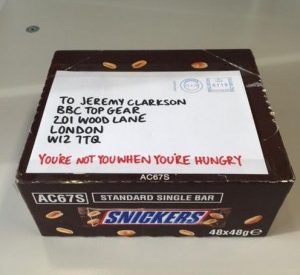Behind the 10-year-old Snickers campaign that launched a global comeback
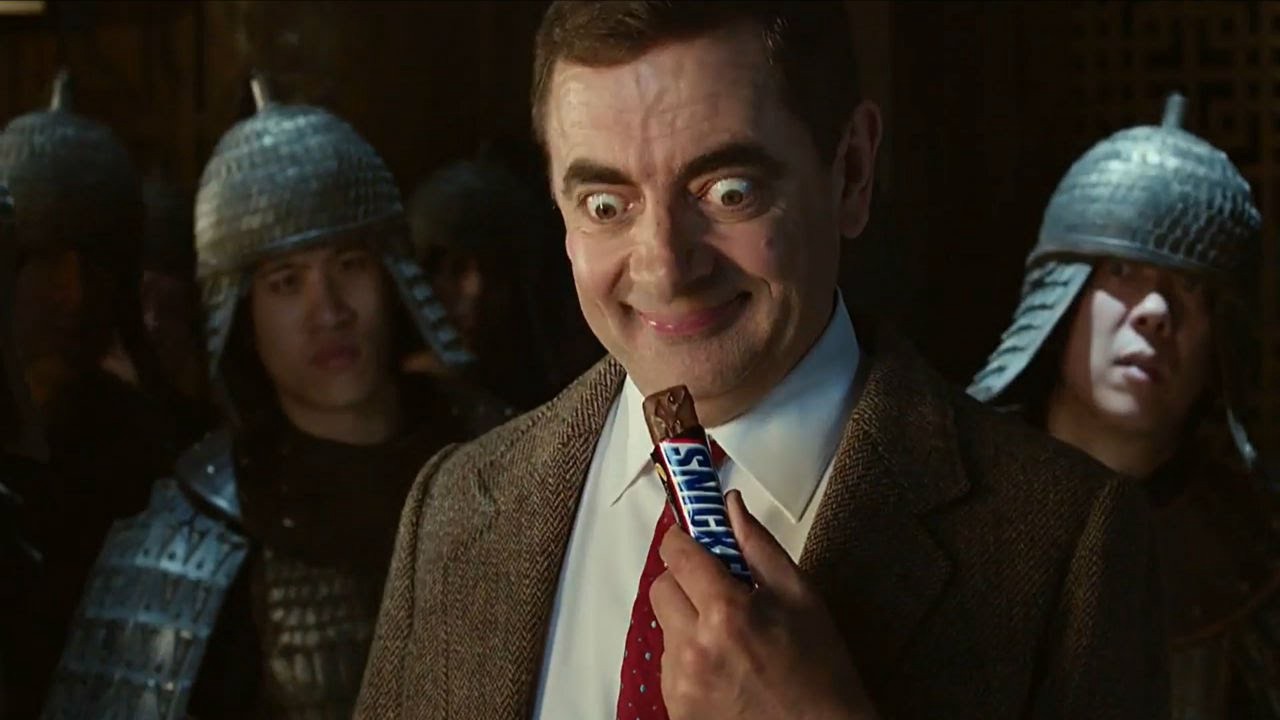 Still from Snickers? TV ad starring Mr. Bean
Still from Snickers? TV ad starring Mr. Bean
Back in 2009, Snickers was in serious trouble. The candy bar began to lose market share, U.S. volume sales were decreasing, and individual markets began to execute on the brand in very different ways. If Snickers remained on the same trajectory, the brand would soon lose its position as the world?s leading chocolate bar?
Here?s an example that shows how Snickers? advertising, which for so long had been a cornerstone of their success, began to lose its way. It?s a 2007 TV ad of a brand that clearly doesn?t quite know what it wants to say:
Snickers? 2007 Super Bowl ad; it isn?t every day you can accuse Snickers of bad taste?
This 30-second commercial, featuring two mechanics who end up sharing both a Snickers bar and an inadvertent kiss, comes with two big problems (apart from the pretty tasteless sense of humor and the controversy that it sparked).
First of all: what are we trying to say about the Snickers brand? How will this type of messaging differentiate the Snickers product from the competitors in the consumer?s consideration set? It just isn?t really clear what the message is here.
Secondly, it?s not a very distinctive campaign either. Other than the packaging shot right at the end, there really aren?t any cues or clues that this is actually a Snickers ad. Even consumers who found the ad funny would struggle the next day to associate it with the Snickers brand, which is, after all, the whole point.
This was the situation the brand had to deal with in the late 2000s. The big challenge was to give Snickers a truly global brand idea; one that could stretch across its 50+ markets, but which could continue to engage audiences in the way they had become used to through their local Snickers campaigns.
Positioning: Snickers? Big Idea
To turn things around, Mars (Snickers? parent company) teamed up with advertising agency BBDO. They started with the very basics: market research and positioning.
Snickers? positioning had always varied along a spectrum from energy recharge on the one end to satisfaction on the other. What they discovered is that the common ground between the two was hunger; when you?re hungry you have less energy, and when you?re satisfied, you?re no longer hungry.
While local markets had kept these two benefits disconnected for years, from a consumer perspective it was essentially arbitrary. In other words, they were basically two sides of the same coin. If Snickers could position their chocolate bar as the bar that stops your hunger, Snickers would do a job for both.
Snickers? ?big idea? (in the words of David Ogilvy) was all about showcasing this story; that when guys get hungry, they?re actually not themselves anymore and their role in the male group is threatened. As a tasty nut-filled bar, Snickers can sort out that hunger and restore your role in the pack.
The Betty White Campaign
Armed with this ?big idea??, Snickers and BBDO started their new campaign in 2010, which began with the famous Super Bowl ad starring Betty White. With this new campaign, you can see that Snickers finally began to communicate the right messages about its brand.
The ad ended up topping USA Today?s Super Bowl Ad Meter. Since 2010, the campaign has expanded to more than 80 countries and has kept viewers laughing with a number of clever spots, with one of the most memorable ones being the 2015 Super Bowl commercial featuring Danny Trejo as a hungry Marcia Brady.
Notably, the Betty White spot in which she appears as a football player who is ?playing like Betty White,? also marked the comeback of Ms. White, who went on to appear on shows such as The Jay Leno Show, The Oprah Winfrey Show, and Larry King Live, and during each of her appearances, the ad was played.
Brilliant Local Executions
Perhaps the most remarkable part of this story is how Snickers? brand team and their agency, BBDO, exported the ad campaign to so many markets. Global campaigns really take off when local teams not only adopt them but are inspired by them to create original local executions.
USA: This one was obviously critical for success, as it is Snickers? number one market. As we?ve seen, Snickers launched the campaign with a bang during the 2010 Super Bowl. Game, featuring Betty White, generated a whopping 91 days of media coverage worth $28.6 million. Not bad for a 30-second TV ad.
Puerto Rico: In Puerto Rico, popular DJs played out-of-character songs (e.g. classical music on a hip-hop station) until an announcer stepped in to reveal that the DJ was hungry and needed a Snickers, reaching 3.2 million people.
UK: As a big Rowan Atkinson fan, my favorite incarnation of the ?You?re Not You When You?re Hungry? campaign is the one made by Snickers UK. The ad features Mr. Bean as a hopeless Kung Fu Master in ancient China:
The Snickers team in the UK continued to pursue fame, using topical and timely tweets, such as the one related to Jeremy Clarkson?s infamous bust-up with a BBC producer. For the cost of a box of Snickers, the PR stunt generated nearly 5,000 retweets and a 92% uplift in profile visits for the Snickers UK Twitter page.
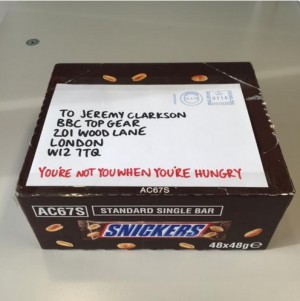
The cheeky tweet also got picked up by numerous publications including BuzzFeed and The Drum, and they even had a friendly response from Clarkson himself, who tweeted the box to his 4.67 million followers saying ?thanks for the support everyone.?
Russia: Snickers? second-biggest market was one of the first to adopt the new campaign. This was a big step as Snickers was already the most-famous chocolate brand in Russia, with a long history of well-loved local ads.
The Russian launch of ?You?re Not You When You?re Hungry,? featuring Russian ballerina Anastasia Volochkova playing basketball with a group of men, generated immediate fame and conversation. The ad generated more than four times as many earned-media placements as the previous campaign.
At this point, you might wonder, ?what are the tangible results of all these efforts??. Well, the brand not only reversed declining volume sales but increased global Snickers volume sales by nearly 16% and grew market share in 56 of the 58 markets in which it ran.
There are obviously things we can learn from such a successful campaign. The point about Snickers adapting their messaging based on each individual country already leads us to the first major lesson we can learn from their famous campaign.
Lesson 1: Drive Global Fame, Locally
Sticking close to the original, the local campaigns subtly inject new flavors of humor and originality that cleverly reflect the newly added Snickers varieties.
Keeping it consistent in style, one message prevails: Snickers is the go-to solution for fast-acting hunger relief. It?s the same familiar tone, with a fresh new approach.
One great example of locally adopted Snickers advertising comes from Snickers Russia. The Russian team in charge of the brand dressed up the Snickers bar in the different packaging of sister brands in the portfolio of parent company Mars. In other words, the actual candy bar was not being itself when it?s hungry:
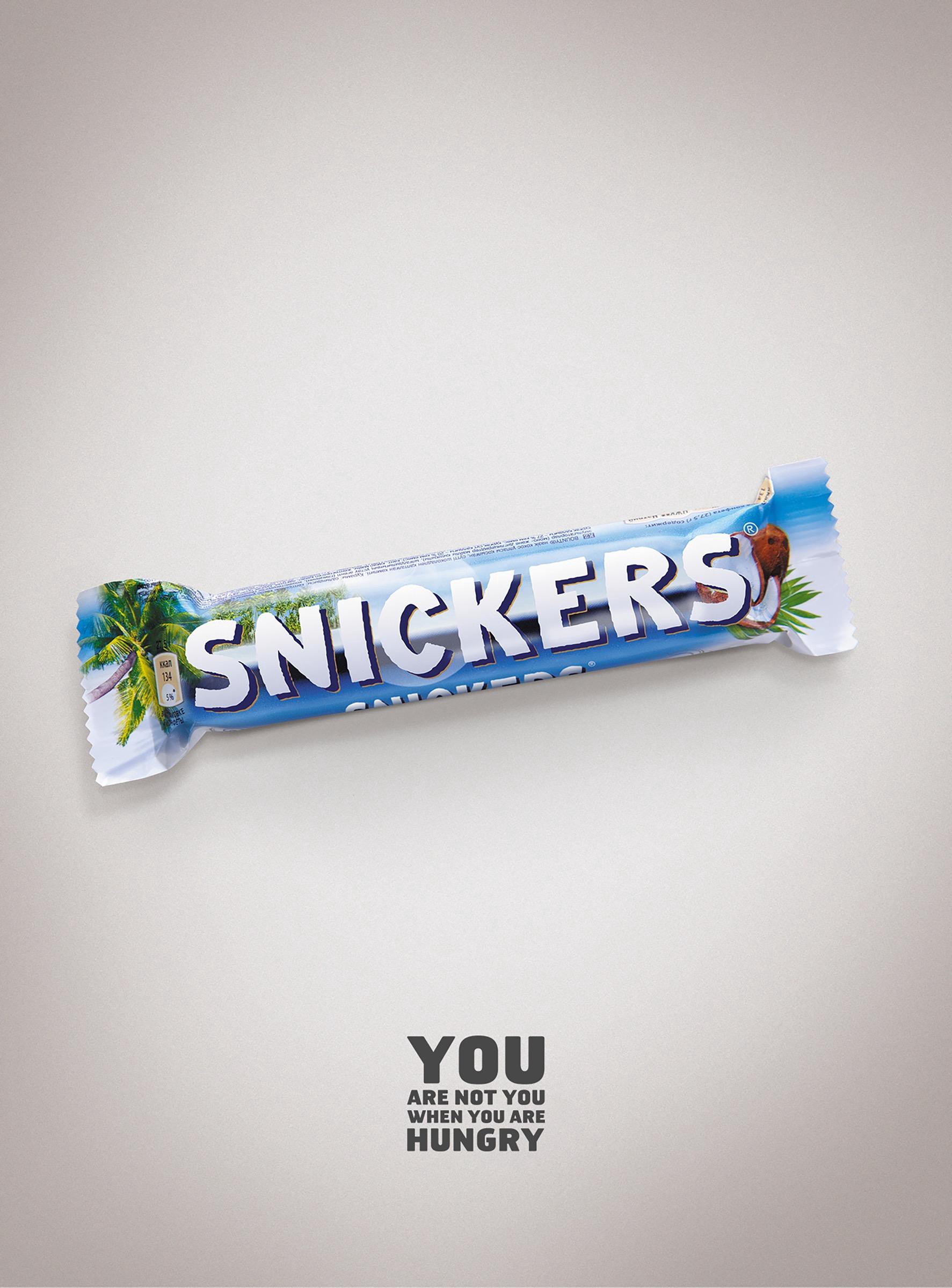
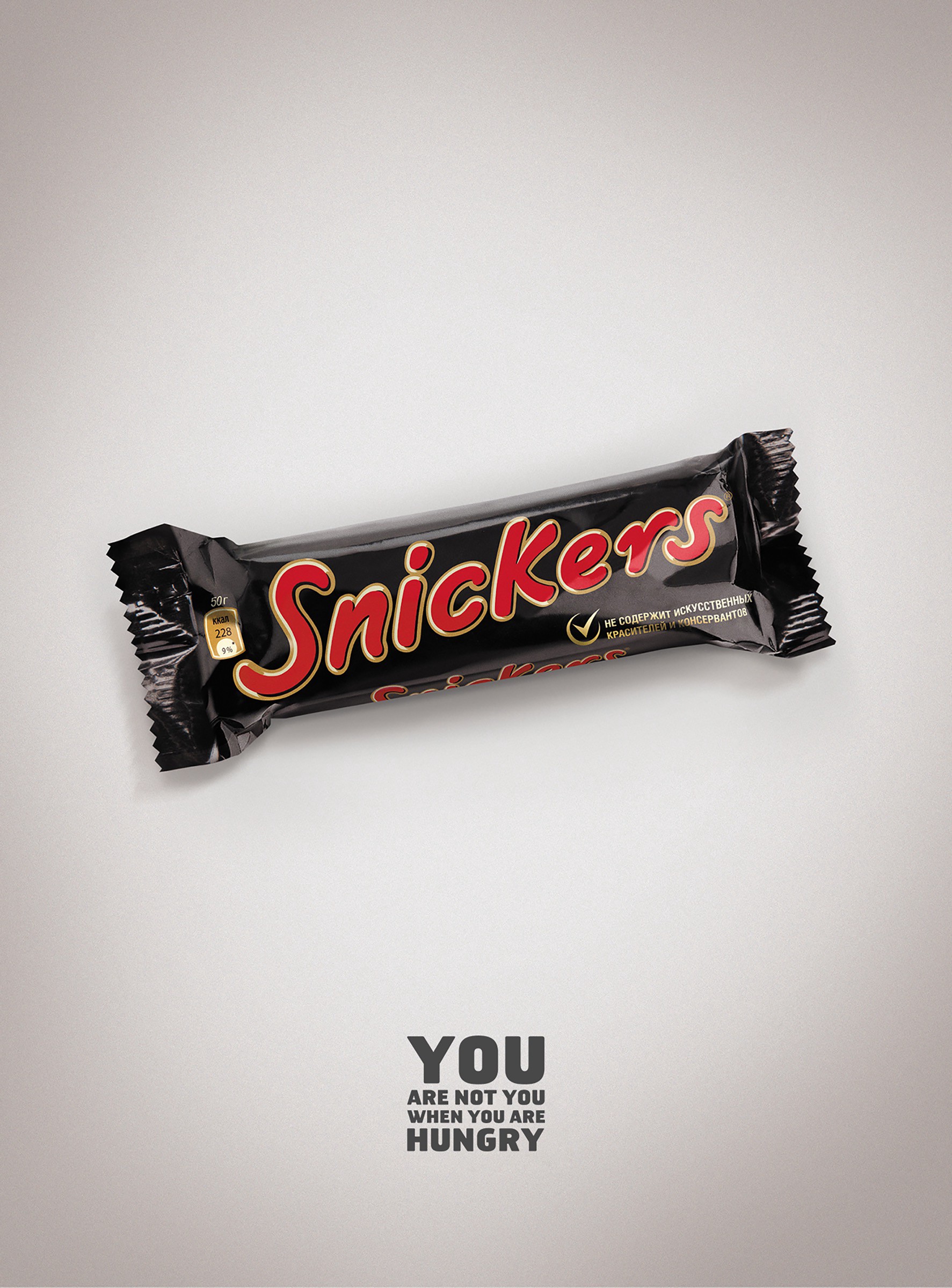
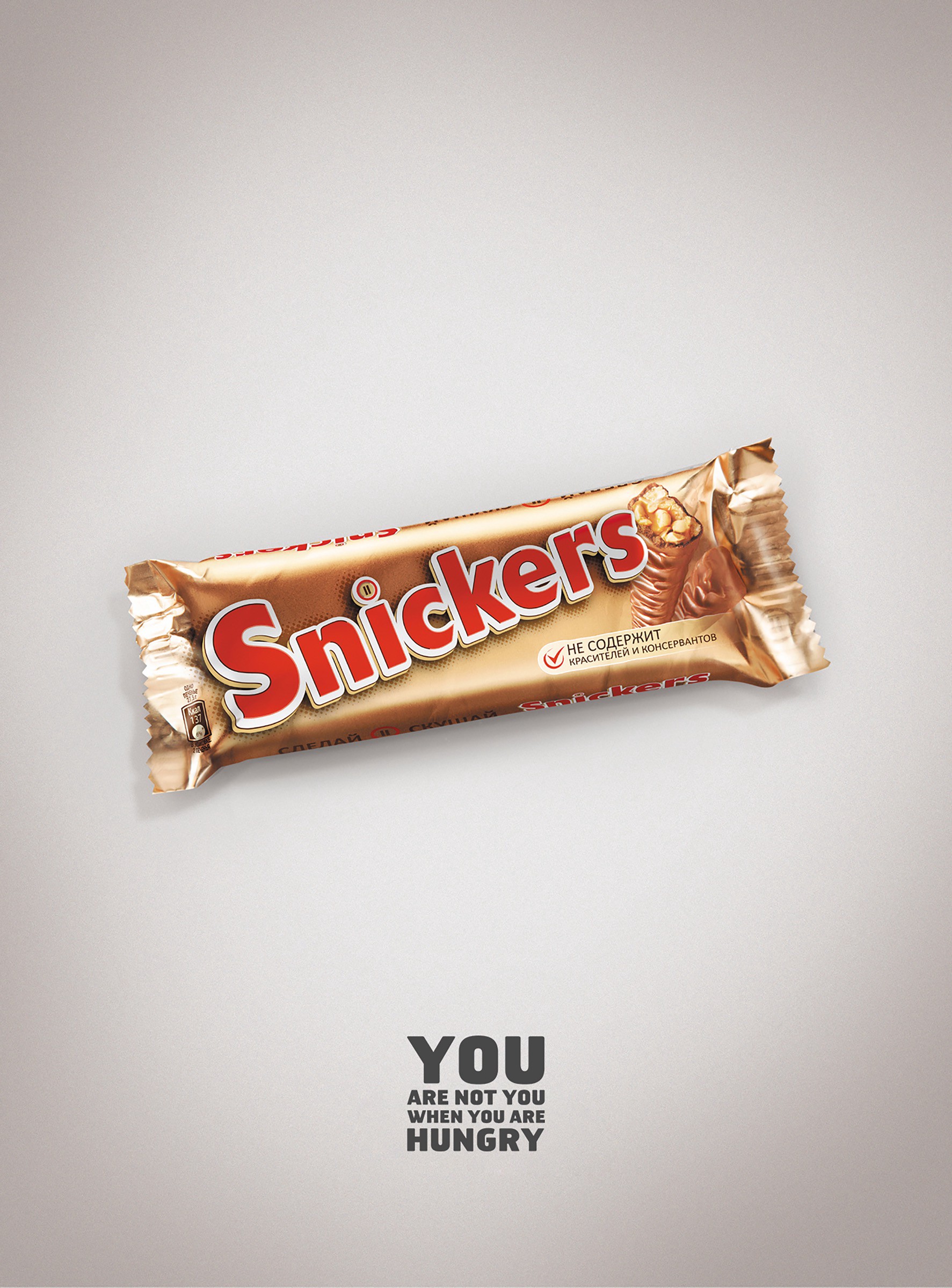 In my opinion, this is genius advertising. From left to right, Snickers dressed up as Bounty, Mars, and Twix.
In my opinion, this is genius advertising. From left to right, Snickers dressed up as Bounty, Mars, and Twix.
Lesson 2: Extend the Idea Beyond Just Ads
Snickers carried the idea into the real world in various creative ways. For instance, in the U.S., they encouraged people to give a Snickers ?Hunger Bar? to friends suffering from different kinds of hunger breakdowns. This personalized approach to packaging seems to have been inspired by Coca-Cola?s wildly successful ?Share a Coke? campaign.

Finally, Snickers introduced a ?Hungerithm? that gauged the mood of the Internet and adjusted the price of its candy bars in 7-Eleven stores accordingly, in real-time. The angrier the Internet got, the cheaper Snickers became.
The concept is pretty brilliant. The Hungerithm monitored social media in order to make these price adjustments, and hangry (hungry + angry) folks could lock in a price and head to their local 7/11 to grab a bar and feel better.
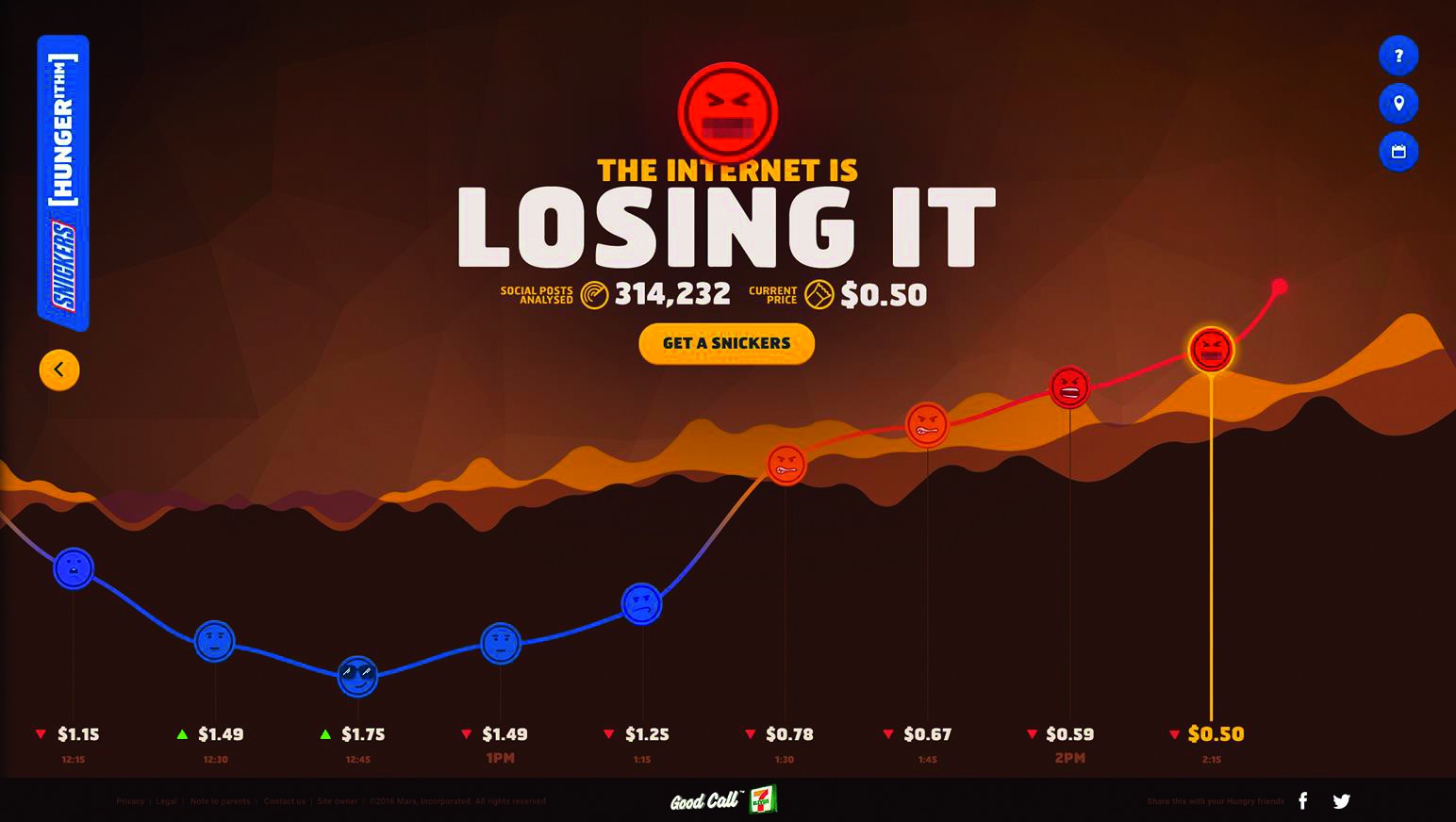 Screenshot of Snickers? Hungerithm website
Screenshot of Snickers? Hungerithm website
Snickers: Satisfied?
Over the past ten years, Snickers has made ?You?re Not You When You?re Hungry? one of the world?s best-loved and most celebrated campaigns. It remains a brilliant example of creating a big, compelling global brand idea with universal appeal, and executing it in a unique and locally relevant way.
There is no rest, though. Snickers is already creating different ideas and campaigns for their beloved chocolate bar. In their latest Super Bowl ad, for instance, they?ve decided it?s not mere individuals who need the candy bar; it?s the entire world?
